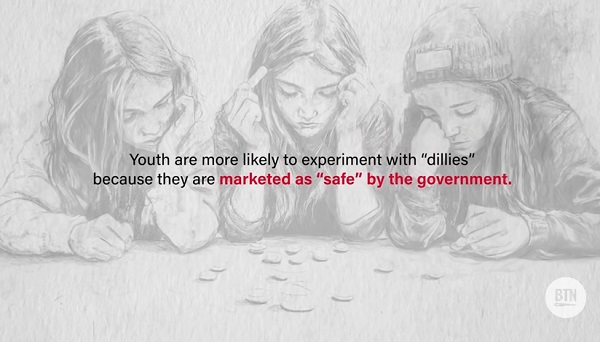Addictions
New documentary exposes safer supply as gateway to teen drug use

By: Alexandra Keeler
In a new documentary, Port Coquitlam teens describe how safer supply drugs are diverted to the streets, contributing to youth drug use
Madison was just 15 when she first encountered “dillies” — hydromorphone pills meant for safer supply, but readily available on the streets.
“Multiple people walking up the street, down the street, saying ‘dillies, dillies,’ and that’s how you get them,” Madison said, referring to dealers in Vancouver’s Downtown Eastside.
Madison says she could get pills for $1.25 each, when purchased directly from someone receiving the drugs through safer supply — a provincial program that provides drug users with prescribed opioids. Madison would typically buy a whole bottle to last a week.
But as her tolerance grew, so did her addiction, leading her to try fentanyl.
“The dillies weren’t hitting me anymore … I tried [fentanyl] and instantly I just melted,” she said.
Kamilah Sword, Madison’s best friend, was just 14 when she died of an overdose on Aug. 20, 2022 after taking a hydromorphone pill dispensed through safer supply.
Madison, along with Kamilah’s father, Gregory Sword, are among the Port Coquitlam, B.C., residents featured in a documentary by journalist Adam Zivo. The film uncovers how safer supply drugs — intended as a harm reduction measure — contribute to harm among youth by being highly accessible, addictive and dangerous.
Through emotional interviews with teens and their families, the film links these drugs to overdose deaths and explores how they can act as a gateway to stronger substances like fentanyl.
Some last names are omitted to respect the victims’ desire for privacy.
Subscribe for free to get BTN’s latest news and analysis, or donate to our journalism fund.
‘Not a myth’
Safer supply aims to reduce overdose deaths by providing individuals with substance use disorders access to pharmaceutical-grade alternatives, such as hydromorphone.
But some policy experts, health officials and journalists are concerned these drugs are being diverted onto the streets — particularly hydromorphone, which is often sold under the brand name Dilaudid and nicknamed “dillies.”
Zivo, the film’s director, points out the disinformation surrounding safer supply diversion, highlighting that some drug legalization activists downplay the issue of diversion.
In 2023, B.C.’s then-chief coroner Lisa Lapointe dismissed claims that individuals were collecting their safer supply medications and selling them to youth, thereby creating new opioid dependencies and contributing to overdose deaths. She labeled such claims an “urban myth.”
In the film, Madison describes how teen substance users would occasionally accompany people enrolled in the safer supply program to the pharmacy, where they would fill their prescriptions and then sell the drugs to the teens.
“It’s not a myth, because my best friend died from it,” she says in the film.
Fiona Wilson, deputy chief of the Vancouver Police Department, testified on April 15 to the House of Commons health committee studying Canada’s opioid crisis that about 50 per cent of hydromorphone seizures by police are linked to safer supply.
 |
Deputy Chief of the Vancouver Police Department, Fiona Wilson, testified on April 15 during the House of Commons ‘Opioid Epidemic and Toxic Drug Crisis in Canada’ health committee meeting.
Additionally, Ottawa Police Sergeant Paul Stam previously confirmed to Canadian Affairs that similar reports of diverted safer supply drugs have been observed in Ottawa.
“Hopefully, by giving these victims a platform and bringing their stories to life, the film can impress upon Canadians the urgent need for reform,” Zivo told Canadian Affairs.
‘Creating addicts’
The teens featured in the film share their experiences with the addictive nature of dillies.
“After doing them for like a month, it felt like I needed them everyday,” says Amelie North, one teen featured in the documentary. “I felt like I couldn’t stand being alive without being on dillies.”
Madison explains how tolerance builds quickly. “You just keep doing them until it’s not enough at all.”
Madison started using fentanyl at the age of 12, leading to a near-fatal overdose after just one hit at a SkyTrain station. “It took five Narcan kits to save my life,” she says in the film.
Many of her friends use dillies or have tried fentanyl, she says. She estimates half the students at her school do.
“Government-supplied hydromorphone is a dangerous domino in the cascade of an addict’s downward spiral to ever more risky behaviour,” said Madison’s mother, Beth, to Canadian Affairs.
“The safe drug supply is creating addicts, not helping addicts,” Denise Fenske, North’s mother, told Canadian Affairs.
“I’m not sure when politicians talk about all the beds they have opened up for youth with drug or alcohol problems, where they actually are and how do we access them?”
Sword, Kamilah’s father, expressed his concern in an email to Canadian Affairs. “I want the people [watching the film] to understand how easy this drug is to get for the kids and how many kids it is affecting, the pain it causes the loved ones, [with] no answers or help for them.”
 |
Screenshot: Dr. Matthew Orde reviewing Kamilah Sword’s toxicology report during his interview for the filming of ‘Government Heroin 2: The Invisible Girls’ in March 2024.
Autopsy
Kamilah’s death raises further concerns.
According to Dr. Matthew Orde, a forensic pathologist featured in the film, Kamilah’s toxicology report revealed a mix of depressants and stimulants, including flualprazolam (a benzo), benzoylecgonine (a cocaine byproduct), MDMA and hydromorphone.
Orde criticizes the BC Coroners Service for not following best practices by focusing solely on cardiac arrhythmia caused by cocaine and MDMA, while overlooking the potential role of benzos and hydromorphone.
Orde notes that in complex poly-drug deaths, an autopsy is typically performed to determine the cause more accurately. He says he was shocked that Kamilah’s case did not receive this level of investigation.
B.C. has one of the lowest autopsy rates in Canada.
Zivo told Canadian Affairs he thinks a public inquiry into Kamilah’s case and other youth deaths involving hydromorphone since 2020 is needed to assess if the province is accurately reporting the harms of safer supply.
“That just angers me that our coroners did not do what most of Canada would have done,” Sword told Canadian Affairs.
“It also makes me question why they didn’t do an autopsy, what is our so-called government hiding?”
Government Heroin 2: The Invisible Girls is available for free on YouTube.
This article was produced through the Breaking Needles Fellowship Program, which provided a grant to Canadian Affairs, a digital media outlet, to fund journalism exploring addiction and crime in Canada. Articles produced through the Fellowship are co-published by Break The Needle and Canadian Affairs.
Subscribe to Break The Needle. Our content is always free – but if you want to help us commission more high-quality journalism, consider getting a voluntary paid subscription.
Addictions
New RCMP program steering opioid addicted towards treatment and recovery

News release from Alberta RCMP
Virtual Opioid Dependency Program serves vulnerable population in Red Deer
Since April 2024, your Alberta RCMP’s Community Safety and Well-being Branch (CSWB) has been piloting the Virtual Opioid Dependency Program (VODP) program in Red Deer to assist those facing opioid dependency with initial-stage intervention services. VODP is a collaboration with the Government of Alberta, Recovery Alberta, and the Alberta RCMP, and was created to help address opioid addiction across the province.
Red Deer’s VODP consists of two teams, each consisting of a police officer and a paramedic. These teams cover the communities of Red Deer, Innisfail, Blackfalds and Sylvan Lake. The goal of the program is to have frontline points of contact that can assist opioid users by getting them access to treatment, counselling, and life-saving medication.
The Alberta RCMP’s role in VODP:
- Conducting outreach in the community, on foot, by vehicle, and even UTV, and interacting with vulnerable persons and talking with them about treatment options and making VODP referrals.
- Attending calls for service in which opioid use may be a factor, such as drug poisonings, open drug use in public, social diversion calls, etc.
- Administering medication such as Suboxone and Sublocade to opioid users who are arrested and lodged in RCMP cells and voluntarily wish to participate in VODP; these medications help with withdrawal symptoms and are the primary method for treating opioid addiction. Individuals may be provided ongoing treatment while in police custody or incarceration.
- Collaborating with agencies in the treatment and addiction space to work together on client care. Red Deer’s VODP chairs a quarterly Vulnerable Populations Working Group meeting consisting of a number of local stakeholders who come together to address both client and community needs.
While accountability for criminal actions is necessary, the Alberta RCMP recognizes that opioid addiction is part of larger social and health issues that require long-term supports. Often people facing addictions are among offenders who land in a cycle of criminality. As first responders, our officers are frequently in contact with these individuals. We are ideally placed to help connect those individuals with the VODP. The Alberta RCMP helps those individuals who wish to participate in the VODP by ensuring that they have access to necessary resources and receive the medical care they need, even while they are in police custody.
Since its start, the Red Deer program has made nearly 2,500 referrals and touchpoints with individuals, discussing VODP participation and treatment options. Some successes of the program include:
- In October 2024, Red Deer VODP assessed a 35-year-old male who was arrested and in police custody. The individual was put in contact with medical care and was prescribed and administered Suboxone. The team members did not have any contact with the male again until April 2025 when the individual visited the detachment to thank the team for treating him with care and dignity while in cells, and for getting him access to treatment. The individual stated he had been sober since, saying the treatment saved his life.
- In May 2025, the VODP team worked with a 14-year-old female who was arrested on warrants and lodged in RCMP cells. She had run away from home and was located downtown using opioids. The team spoke to the girl about treatment, was referred to VODP, and was administered Sublocade to treat her addiction. During follow-up, the team received positive feedback from both the family and the attending care providers.
The VODP provides same-day medication starts, opioid treatment transition services, and ongoing opioid dependency care to people anywhere in Alberta who are living with opioid addiction. Visit vodp.ca to learn more.
“This collaboration between Alberta’s Government, Recovery Alberta and the RCMP is a powerful example of how partnerships between health and public safety can change lives. The Virtual Opioid Dependency Program can be the first step in a person’s journey to recovery,” says Alberta’s Minister of Mental Health and Addiction Rick Wilson. “By connecting people to treatment when and where they need it most, we are helping build more paths to recovery and to a healthier Alberta.”
“Part of the Alberta RCMP’s CSWB mandate is the enhancement of public safety through community partnerships,” says Supt. Holly Glassford, Detachment Commander of Red Deer RCMP. “Through VODP, we are committed to building upon community partnerships with social and health agencies, so that we can increase accessibility to supports in our city and reduce crime in Red Deer. Together we are creating a stronger, safer Alberta.”
Addictions
Saskatchewan launches small fleet of wellness buses to expand addictions care

By Alexandra Keeler
Across Canada, mobile health models are increasingly being used to offer care to rural and underserved communities
Saskatchewan has launched a small fleet of mobile wellness buses to improve access to primary health care, mental health and addiction services in the province.
The first bus began operating in Regina on Feb. 12. Another followed in Prince Albert on March 21. Saskatoon’s bus was unveiled publicly on April 9. All three are former coach buses that have been retrofitted to provide health care to communities facing barriers to access.
“Mobile health units are proven to improve outcomes for people facing barriers to healthcare,” Kayla DeMong, the executive director of addiction treatment centre Prairie Harm Reduction, told Canadian Affairs in an email.
“We fully support this innovative approach and are excited to work alongside the health bus teams to ensure the people we support receive the care they need, when and where they need it.”
Wellness buses
Like all provinces, Saskatchewan has been grappling with the opioid crisis.
In 2023, an estimated 457 individuals died from overdoses in the province. In 2024, that number fell to 346. But the province continues to struggle with fatal and non-fatal overdoses.
In late February, Saskatoon firefighters responded to more than 25 overdoses in a single 24-hour period. Just over a week later, they responded to 37 overdoses within another 24-hour window.
Saskatchewan’s wellness buses are part of the province’s plan to address these problems. In April 2025, the province announced $2.4 million to purchase and retrofit three coach buses, plus $1.5 million in annual operating funds.
The buses operate on fixed schedules at designated locations around each city. Each bus is staffed with a nurse practitioner, nurse and assessor coordinator who offer services such as overdose reversal kits, addiction medicine and mental health referrals.
“By bringing services directly to where people are, the health buses foster safer, more welcoming spaces and help build trusting relationships between community members and care providers,” said DeMong, executive director of Prairie Harm Reduction.
Saskatoon-based Prairie Harm Reduction is one of the local organizations that partners with the buses to provide additional support services. Prairie Harm Reduction provides a range of family, youth and community supports, and also houses the province’s only fixed supervised consumption site.
The mobile model
Saskatchewan is not the only province using wellness buses. Across Canada, mobile health models are increasingly being used to expand access to care in rural and underserved communities.
In Kingston, Ont., the Street Health Centre operates a retrofitted RV called PORCH (Portable Outreach Care Hub) that serves individuals struggling with homelessness and addiction.
“Our outreach services are extremely popular with our clients and community partners,” Donna Glasspoole, manager at Street Health Centre, said in an emailed statement.
“PORCH hits the road two to three days/week and offers a variety of services, which are dependent on the health care providers and community partners aboard.”
Street Health Centre also has a shuttle service that picks up clients in shelters and brings them to medical clinics or addiction medicine clinics.
The PORCH vehicles are not supported by provincial funding, but instead rely on support from the United Way and other grants. Glasspoole says the centre’s permanent location — which does receive government funding — is more cost-effective to operate.
“The vehicles are expensive to operate and our RV is not great in winter months and requires indoor parking,” she said.

Politically palatable
Many mobile health models currently do not provide controversial services such as supervised drug consumption.
The Saskatchewan Health Authority told Canadian Affairs the province’s new wellness buses will not offer supervised consumption services or safer supply, where drug users are given prescribed opioids as an alternative to toxic street drugs.
“There are no plans to provide supervised consumption services from the wellness buses,” Saskatchewan Health Authority spokesperson Courtney Markewich told Canadian Affairs in a phone call.
This limited scope may make mobile services more politically palatable in provinces that have resisted harm reduction measures.
In Ontario, some harm reduction programs have shifted to mobile models following Premier Doug Ford’s decision to suspend supervised consumption services located within 200 metres of schools and daycares.
In April, Toronto Public Health ended operations at its Victoria Street fixed consumption site, replacing it with street outreach and mobile vans.
The Ontario government’s decision to close the sites is part of a broader pivot away from harm reduction. The province is investing $378 million to transition suspended sites into 19 new “HART Hubs” that offer primary care, mental health, addictions treatment and other supports.
Glasspoole says that what matters most is not whether services are provided at fixed or mobile locations, but how care is delivered.
Models that “reduce barriers to care, [are] non-judgemental, and [are staffed by] trauma-informed providers” are what lead more people toward treatment and recovery, she said in her email.
In Saskatchewan, DeMong hopes the province’s new wellness buses help address persistent service gaps and build trust with underserved communities.
“This initiative is a vital step toward filling long-standing gaps in the continuum of care by providing low-barrier, community-based access to health-care services,” she said.
This article was produced through the Breaking Needles Fellowship Program, which provided a grant to Canadian Affairs, a digital media outlet, to fund journalism exploring addiction and crime in Canada. Articles produced through the Fellowship are co-published by Break The Needle and Canadian Affairs.
Subscribe to Break The Needle
-

 Alberta2 days ago
Alberta2 days agoCalls for a new pipeline to the coast are only getting louder
-

 Business2 days ago
Business2 days agoCanada’s economic pain could be a blessing in disguise
-

 Censorship Industrial Complex2 days ago
Censorship Industrial Complex2 days agoJordan Peterson reveals DEI ‘expert’ serving as his ‘re-education coach’ for opposing LGBT agenda
-

 Alberta2 days ago
Alberta2 days agoUnified message for Ottawa: Premier Danielle Smith and Premier Scott Moe call for change to federal policies
-

 Education2 days ago
Education2 days agoStudents can’t use AI to cheat on standardized tests
-

 International2 days ago
International2 days agoTrump puts new price tag on Canada joining “Golden Dome”
-

 Economy1 day ago
Economy1 day agoOttawa’s muddy energy policy leaves more questions than answers
-

 Business2 days ago
Business2 days agoRhetoric—not evidence—continues to dominate climate debate and policy







